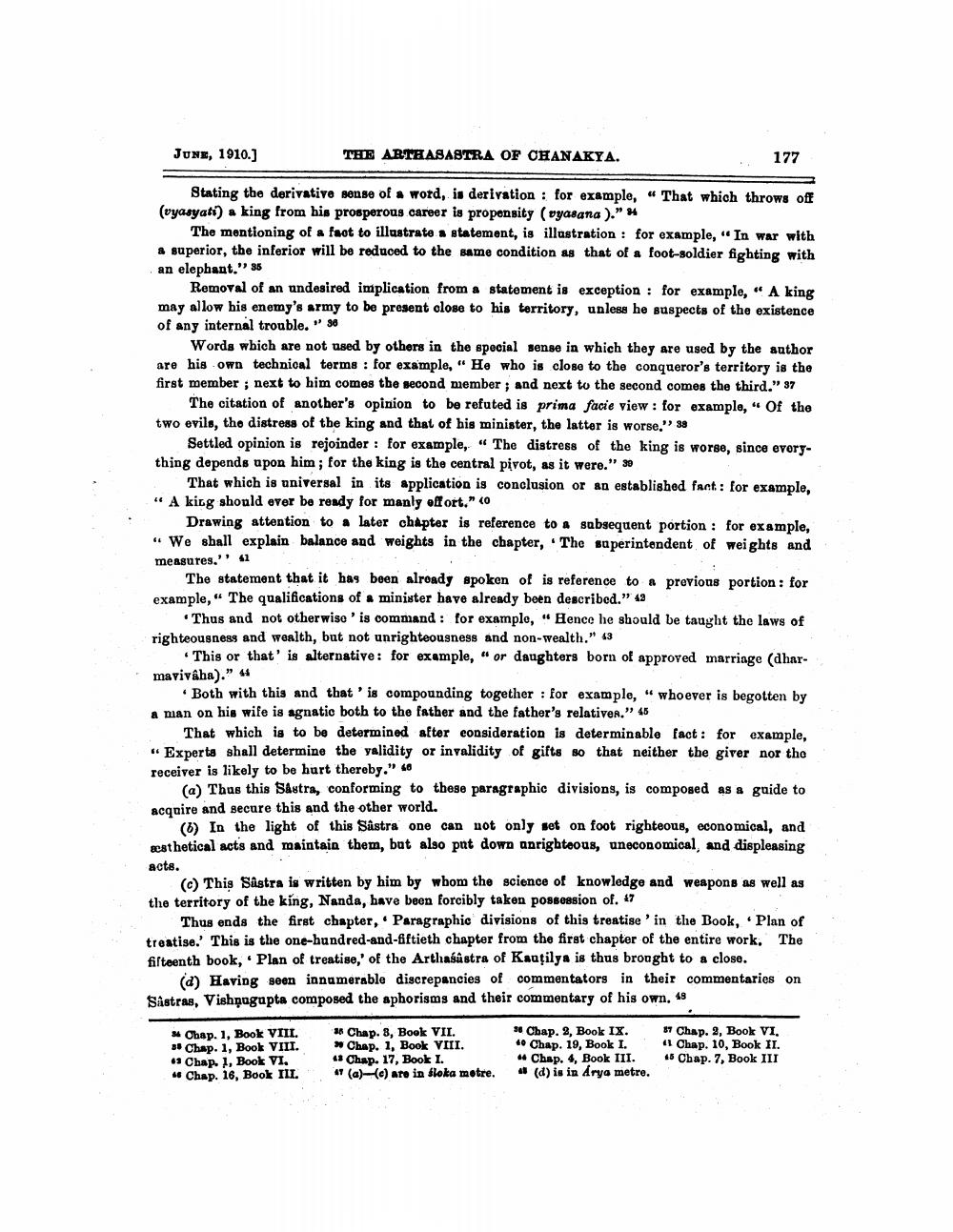________________
JUNE, 1910.)
THE ARTHASASTRA OF CHANAKYA.
177
Stating the derivative sense of a word, is derivation : for example, " That which throws off (vyasyat) a king from his prosperous career is propensity (vyasana )." **
The mentioning of a faot to illustrate a statement, is illustration : for example, "In war with a superior, the inferior will be reduced to the same condition as that of a foot-soldier fighting with an elephant." 35
Removal of an undesired implication from a statement is exception : for example, " A king may allow his enemy's army to be present close to his territory, unless he suspects of the existence of any internal trouble." 30
Words which are not used by others in the special sense in which they are used by the author are his own technical terms : for example, " He who is close to the conqueror's territory is the first member; next to him comes the second member; and next to the second comes the third." 37
The citation of another's opinion to be refuted is prima facie view : for example, " Of the two evils, the distress of the king and that of his minister, the latter is worse." 38
Settled opinion is rejoinder : for example, " The distress of the king is worse, since everything depends upon him; for the king is the central pivot, as it were." 30
That which is universal in its application is conclusion or an established fant: for example, " A king should ever be ready for manly effort." (0
Drawing attention to later chapter is reference to a subsequent portion : for example, "We shall explain balance and weights in the chapter, The saperintendent of weights and measures.'' 41
The statement that it has been already spoken of is reference to a previous portion : for example, " The qualifications of a minister have already been described." 19
Thus and not otherwise 'is command: for example, " Hence he should be taught the laws of righteousness and worlth, but not unrighteousness and non-wealth.” 13
This or that is alternative: for example, " or daughters born of approved marriage (dharmavivaha)." +
Both with this and that 'is compounding together : for example, “whoever is begotten by A man on his wife is agnatic both to the father and the father's relativer." 45
That which is to be determined after consideration is determinable fact : for example, "Experts shall determine the validity or invalidity of gifts so that neither the giver nor the receiver is likely to be hart thereby." 40
(a) Thus this Sastra, conforming to these paragraphic divisions, is composed as a guide to acquire and secure this and the other world.
(6) In the light of this Sastra one can not only set on foot righteous, economical, and esthetical acts and maintain them, but also put down anrighteous, uneconomical, and displeasing acts.
(c) This Sastra is written by him by whom the science of knowledge and weapons as well as the territory of the king, Nanda, have been forcibly taken possossion of. 47
Thus ends the first chapter, Paragraphic divisions of this treatise' in the Book, Plan of treatise. This is the one-hundred-and-Giftieth chapter from the first chapter of the entire work. The fifteenth book, Plan of treatise,' of the Arthasûstra of Kautilya is thus bronght to a close.
d) Having seen innumerable discrepancies of commentators in their commentaries on Sastras, Vishnugapta composed the aphorisms and their commentary of his own, 48
# Chap. 1, Book VIII. 3 Chap. 1, Book VIII. "1 Chap. 1, Book VI. # Chap. 16, Book III.
** Chap. 8, Book VII. » Chap. 1, Book VIII. ** Chap. 17, Book L. 41 (a)-(e) are in floka metre.
# Chap. 2, Book Ix. *Chap. 19, Book I. # Chap. 4, Book III.
(d) is in drys metre.
B7 Chap. 2, Book VI.
Chap. 10, Book II. 15 Chap. 7, Book III




